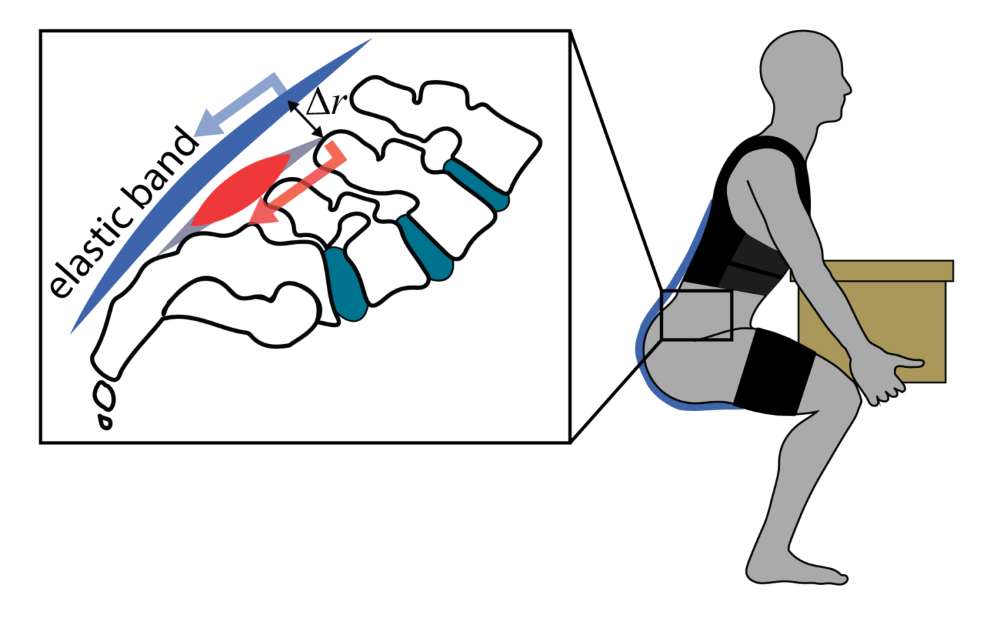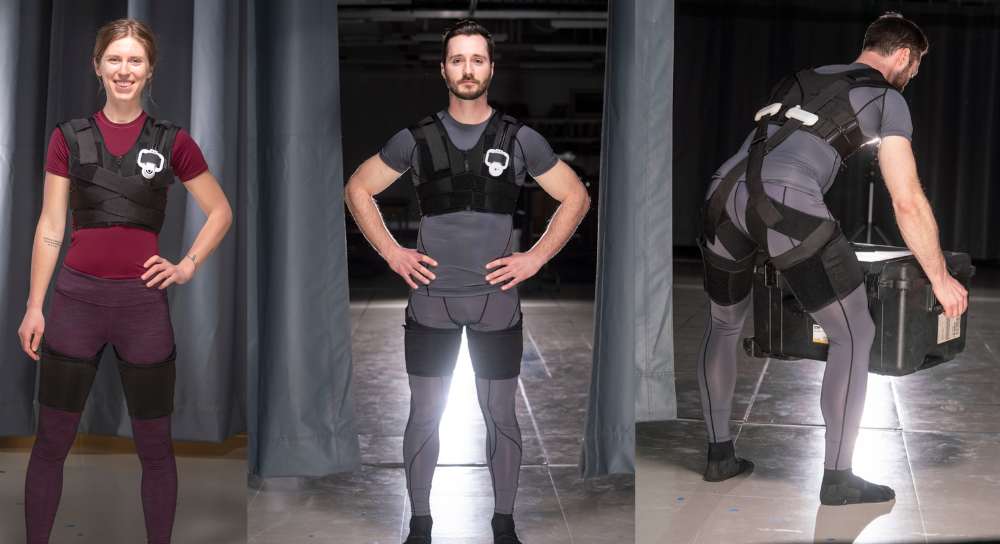A lot of jobs are tough on the back, specifically the lower muscles that extend the lumbar spine.
Vanderbilt University engineers are proving that their elastic exosuit can provide relief for people doing the heavy lifting.
Recent tests of the device demonstrated that the back-assist exosuit, which supports human movement and posture, reduced the fatigue of six subjects by an average of 29 to 47 percent in lower back muscles. Such results could provide relief for workers like nurses, material handlers, construction workers, and automotive assemblers who frequently perform tasks that are demanding on the spine.
The device can be worn underneath or over typical daily clothing. The wearable uses elastic elements — and no batteries or motors — to apply assistive forces, in parallel with the lumbar extensor muscles.
Energy is stored in the suit's elastic bands during the lifting motion. The 3-pound exosuit is easy to wear and takes about 50 pounds of strain off the back each time a user bends or lifts, according to lead researcher and Assistant Professor of Mechanical Engineering Karl Zelik.
"It feels like wearing a small CamelBak backpack and a pair of light compression shorts," says Zelik. "It takes 30 seconds to put on, and 10 seconds to take off."
The exosuit has elastic bands that act almost like artificial lats — the V-shaped muscles that connect your arms to your vertebral column. The bands along the suit's back stretch when the user bends forward or crouches down to lift, creating an assistive torque about the low-back and hips that offloads the lumbar and hip extensor muscles.
"Essentially we direct a portion of the load through the elastic bands rather than through the user's back muscles," Zelik told Tech Briefs.
{youtube} https://m.youtube.com/watch?v=vhPD8WyXLsk {/youtube}
The device consists of two fabric sections for the chest and legs. The material was selected to be lightweight and breathable, says Zelik. The fabric sections are connected by elastic bands along the back and glutes.
Additionally, the exosuit is designed to assist only when required, and otherwise it stays disengaged and out of the way. A manual switch on the shoulder turns exosuit assistance on and off.
When the manual switch is flipped to "on" mode, a clutch, or locking mechanism, engages a stiff elastic band. When the manual switch is turned to "off," the clutch releases the stiff elastic band, so that no assistance or resistance is felt as the person moves around.
The team's study showed that wearing the exosuit made holding a 35-pound weight less tiring on the back than carrying a 24-pound weight without the exosuit.
Along with primary author Erik Lamers, Zelik used surface electromyography techniques to measure changes in low back muscle fatigue in male and female participants, who were given the different physical tasks to perform both with and without the exosuit.
The subjects demonstrated consistent reductions in fatigue rate (ranging from 26% to 87%) for a subset of lumbar muscles (ranging from one to all six lumbar muscles measured).
The article describing the experiment and findings, “ Low-Profile Elastic Exosuit Reduces Back Muscle Fatigue ,” was published in the Nature journal Scientific Reports on September 29.
Since completion of this study, the back-assist technology has been commercialized into the HeroWear Apex exosuit.
“These findings show how exosuits could provide valuable back relief to frontline and essential workers who have been taking a physical toll and supporting all of us throughout this pandemic. What we learned has the potential to shape the biomechanical and industrial standards of future wearable technologies,” said Zelik in a recent press release .

In a short Q&A below, Zelik explains how he envisions the exosuit being used in the workplace.
Tech Briefs: What inspired you to build this exosuit?
Karl Zelik: I blame my kids for all the lifting, carrying, and bending that goes into parenting young children.
I started developing some back pain a few years ago, and started thinking about whether there was a way to create a practical, low-profile, lightweight, assistive exoskeleton that would fit into my own daily life without interfering.
After failing to find a commercial solution, we started to explore our new concepts in my research lab at Vanderbilt. We've spent the last four years exploring different designs, performing a series of lab and field experiments, and working through numerous design iterations, before eventually launching the commercial exosuit earlier this year.
Tech Briefs: You mention in the press release that “ Wearables are going to change the way we work and live .” Can you bring us through a favorite – or if not favorite, typical – example application that you envision?
Karl Zelik: I'm a fan of any technology that can help keep people happy, healthy and energized — both on and off the job. Imagine your job involved lifting and moving 35-pound boxes throughout the day, for instance in a warehouse. It's exhausting, physically-demanding work.
Now imagine lifting and moving the same number of boxes, but each one was lightened to 20 pounds. It's still challenging work, but it's much less strain on your body, which means less risk of injury due to overexertion and probably more energy at the end of the workday to go home and spend time with your family or do the things you love.
Exosuits have the potential to provide this kind of physical relief. This could help many people across a range of occupations (material handling, construction, nursing, etc.) and directly affect how they live, work, and feel on a daily basis.
Tech Briefs: Do you consider this to be a device that you would wear all day?
Karl Zelik: For some jobs it may make sense to wear the exosuit all day given the high frequency of lifting and bending. For other jobs, there may only be intermittent tasks where back assistance is helpful — and these users may choose to don/doff the exosuit as needed.
Tech Briefs: From a technology perspective, how is your wearable different from existing exosuits?
Karl Zelik: This exosuit combines a unique blend of features and capabilities based on countless hours we spend observing workers and getting their feedback on aspects of the device that are most important to them. The key attributes of the exosuit are:
- It's soft — made mostly from textiles and elastomers, which makes it comfortable like clothes.
- It's unobtrusive, so you can switch assistance on/off, such that the device does not get in the way of other daily tasks. Device interference has been a big obstacle to industry adoption for previous exoskeletons, so one of the proprietary (patent-pending) aspects of our design is the dual-mode (on/off) switch feature.
- It's passive, so no batteries to charge or heavy motors to carry.
- It's effective, with multiple peer-reviewed scientific publications proving how the exosuit relieves back strain and fatigue.
- Finally, it has a modular design to adjust to different body types, and is the first commercial exoskeleton or exosuit designed with both female- and male-specific fits.
Would you wear this exosuit? Share your questions and comments below.


